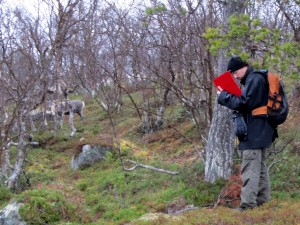Guillaume Body
PhD. Student
Contact Information
Department of Biology
Concordia University (Loyola Campus)
7141 Sherbrooke St. W. H4B 1R6
Montreal, QC, Canada
Office: XXX
Lab: SP434
(514) 848-2424 (ext. 4021)
Education
2010 – Present: PhD in Ecology at Concordia University, Montreal, Canada
2007-2008: MSc second year in Ecology, Evolution, Biometry at Lyon 1 University, Lyon, France
2006-2007: MSc first year in Biology of Organisms, Populations and Ecosystems at Rennes 1 University, Rennes, France
2003-2006: BSc in Biology of Populations and Ecsystems, University Aix-Marseille 3, Marseille, France
My Project
Reindeer Rangifer tarandus female mating tactics: dealing with the fission-fusion dynamic system
Background
Sexual selection in ungulates has been studied for a long time from the male point of view. However, scarce evidences of female mate choice (the inter-sexual selection) can be found behind male fight in well known populations and there is an increasing number of studies on this topic. Female can select male for indirect benefit (“good genes” hypothesis) or for direct benefit (“harassment avoidance” hypothesis) through different process independent of the benefit obtained. Inter-sexual selection can be coincidental if natural female behaviors induce a bias in male mating opportunities (e.g. through habitat selection, anti-predator aggregations), can be an indirect mate choice if female behaviors increase competition among males (e.g. by inducing fights) or can be a direct mate choice if they use criteria to select their mate (e.g. male antler size, but the level of harassment in a group could also be such a criterion). Females have to use a sampling tactic in this last case in order to evaluate a criterion.
Reindeer mating system is based on a fission-fusion group dynamic system, groups often split and mix. In addition, male dominance is not stable. Therefore, daily group compositions are not able to record precisely the among groups trajectory of females and, more important, are not able to distinguish whether a female change between two group is active (=voluntary) or passive (=following the group dynamic).
Using GPS data, I will establish the dynamic of groups during the mating season of a reindeer population, then I will investigate the active movement of females among groups as an indicator of their selection behavior.
Field Work
We will be studying a well known reindeer population from the Kutuharju Field Reindeer Research Station in Kaamanen, Finland (69°N, 27°E), a well know enclosed semi-domestic population. Each individual in this population will be equipped with a Tellus GPS collar which includes an activity sensor. All of them are synchronized in order to obtain the real spatial distribution of individuals in the population at a precise frequency. Groups’ definition and composition will be obtained by spatial analyses.
Objectives
The objective of my PhD is to investigate whether reindeer female active movements among groups are sampling tactic and whether leaving a group is a sign of mate-choice preference using telemetry data.
- Develop the methodology to record group dynamic from GPS data in a fully equipped population.
- Develop indices of group harassment level and estrous detection from activity sensors.
- Determine whether females are sampling their mates during the mating season.
- Identify the sampling tactic by testing if the “good genes” hypothesis or the “harassment avoidance” hypothesis is able to explain females’ movements during the mating season.
Publications
- Body G, Weladji RB, Holand Ø, Nieminen M (2014) Male Mating behaviour in relation to the temporal variation in operational sex ratio. 1st joint meeting of the Canadian Society of Ecology and Evolution, the Canadian Society of Zoology and the Society of Canadian Limnologist. 25-29 May, 2014, Montréal, Québec, Canada (oral presentation)
- Body G, Ucchuddu S, Weladji RB, Holand Ø, Nieminen M (2013) La competition pour la recherché alimentaire dans les grands groups compense les benefices de l’évitement du harcèlement chez les femelles rennes. Symposium on Biodiversity Science, 12-13 December, 2013, Montréal, Québec, Canada (oral presentation)
- Body G, Weladji RB, Holand Ø, Nieminen M (2013) Le système d’appariement en harem instable chez le renne. 38th Annual Meeting of Société Québécoise pour l’Etude Biologique du Comportement, 8-10 November, 2012, Montréal, Québec, Canada (page 15, oral presentation)
- Body G, Weladji RB, Holand Ø, Nieminen M (2012) Male herding ability explains the increase of the average group size in reindeer during rut. 2012 Symposium on Biodiversity Science, 13-14 December, 2012, Montréal, Québec, Canada (Page 39, oral presentation)
- Body G, Weladji RB, Holand Ø, Nieminen M (2012) The fission-fusion dynamics of reindeer groups: variation during the rut. 37th Annual Meeting of Société Québécoise pour l’Etude Biologique du Comportement, 2-4 November, 2012, Montréal, Québec, Canada (page 3, oral presentation)
- G. Body, R.B. Weladji & Ø. Holand (2012) The recursive model as a new approach to validate and monitor activity sensors. Behavioral Ecology and Sociobiology66:1531-1541
- G. Body, O Holand, R.B. Weladji (2011) Linking group size to group dynamic: an exploratory analysis using GPS data. 1st Joint Congress on Evolutionary Biology. July 6-10th, 2012, Ottawa, Ontario, Canada (Page 94, oral presentation).
- G. Body, O Holand, R.B. Weladji (2011) L’apport de la technologie GPS au suivi de la dynamique de fusion-fission des groupes: exemple du rut du renne Rangifer tarandus. Colloque annuel du Centre de la Science de la Biodiversité du Québec, 8-9 December, 2011, Montréal, Québec, Canada (Page 30, oral presentation).
- G. Body, Ferté H, Gaillard J-M, Delorme D, Klein F, Gilot-Fromont E (2011) Population density and phenotypic attributes influence the level of nematode parasitism in roe deer. Oecologia 167: 635-646
- Gayet G, Guillemain M, Fritz H, Mesleard F, Begnis C, Costiou A, Body G, Curtet L, BroyerJ (2011) Do Mute swan (Cygnus olor) grazing, swan residence and fishpond nutrient availability interactively control macrophyte communities? Aquatic Botany 95: 110-116